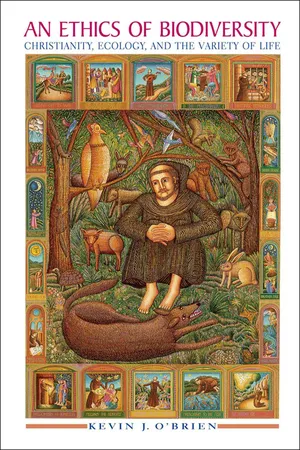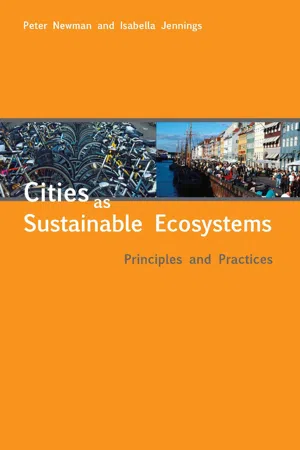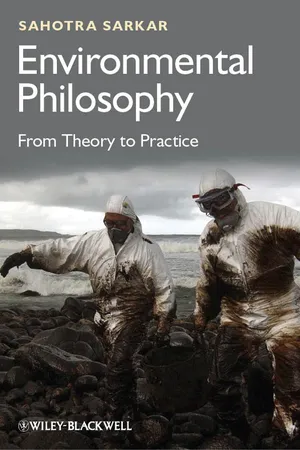Biological Sciences
Biodiversity
Biodiversity refers to the variety of life forms within a specific ecosystem, including diversity at the genetic, species, and ecosystem levels. It encompasses the multitude of different species, their genetic variations, and the complex interactions between them. Biodiversity is crucial for ecosystem stability, resilience, and the provision of ecosystem services essential for human well-being.
Written by Perlego with AI-assistance
Related key terms
6 Key excerpts on "Biodiversity"
- eBook - ePub
An Ethics of Biodiversity
Christianity, Ecology, and the Variety of Life
- Kevin J. O'Brien(Author)
- 2010(Publication Date)
- Georgetown University Press(Publisher)
Three distinct but compatible definitions emerge: a broad scientific definition that captures the reality of Biodiversity, a more precise ecological definition representing the research goals of scientists who study and measure the concept, and a third definition linking the Biodiversity of this planet to the Christian doctrine of creation. Understood together, these definitions reveal how much is contained in the concept of Biodiversity and how complex a thoughtful response to it must be.Two Scientific Definitions of Biodiversity
Most ecologists who study Biodiversity see themselves as seeking not only to understand it but also to contribute to its protection. Some of these scientists have taken to identifying themselves within a related academic field, conservation biology, to emphasize that they apply their research to a particular environmentalist agenda.2 However, even among researchers who agree that Biodiversity must be conserved, there are important disagreements about whether it serves their research and cause better to articulate a narrow, clear, and quantifiable definition or a broad, inclusive, and adaptable one.These distinct approaches to a scientific definition are introduced well by E. O. Wilson in a 1997 book of essays about Biodiversity:So what is it? Biologists are inclined to agree that it is, in one sense, everything. Biodiversity is defined as all hereditarily based variation at all levels of organization, from the genes within a single local population or species, to the species composing all or part of a local community, and finally to the communities themselves that compose the living parts of the multifarious ecosystems of the world. The key to effective analysis of Biodiversity is the precise definition of each level of organization when it is being addressed.3 - eBook - ePub
- Roger A. Professor Sedjo(Author)
- 2010(Publication Date)
- Routledge(Publisher)
1 We begin by reviewing the various definitions of Biodiversity, the measurement of Biodiversity, and the role of Biodiversity in ecosystem processes. Thereafter, we discuss the current status of Biodiversity in the United States as well as the number of species in the various regions of the country. Then, we discuss Biodiversity loss, summarizing current knowledge about species endangerment and extinction, and their causes. We next review the economic literature on Biodiversity as a source for values related to human welfare, as well as summarize estimated values for rare, threatened, and endangered species and habitat. Subsequently, we explain the protection of Biodiversity in the United States, a discussion that revolves around the Endangered Species Act but considers the increasingly important role of other approaches to Biodiversity conservation, including public protected areas, land trusts, and forest certification programs. A discussion concerning the relationship between sustainability and Biodiversity concludes the chapter.What Is Biodiversity?
Biodiversity refers to the overall biological variety of life, which is a complex notion with several definitions. Often, statements of Biodiversity refer to the number of species in a geographical area. However, Biodiversity occurs at other levels of organization, including genetic variation among different individuals or populations within a particular species. The range of ecosystems, such as forests, agricultural areas, wetlands, mountains, lakes, and rivers, and differences between and within geographical landscapes, regions, countries, and continents are also important dimensions of Biodiversity.Definitions
Biodiversity typically is considered at three levels: species diversity, genetic diversity, and ecosystem diversity. Species diversity is the variety and abundance of species in a geographical area. The number of species in a given area, known as species richness, is the simplest and arguably most commonly used measure of Biodiversity. Species are the central unit in Biodiversity studies and conservation, at least in part because ecosystems are hard to delimit and genes have until recently been difficult to count and identify. A species is the basic unit of organism classification. It is typically defined as a group of similar organisms that interbreed in nature or share a common, genetically distinct lineage of descent. However, each species consists of subspecies (i. e., geographical races), populations, and individuals, each possessing its own levels of genetic distinctiveness. A population is a geographically distinct group of individuals of a particular species. An evolutionarily significant unit (ESU) is a population or group of populations that is substantially reproductively isolated and is sufficiently genetically unique from other populations to make it an important evolutionary component of the species. Although Biodiversity is often measured using species richness, practical species management and conservation efforts often target populations and ESUs rather than entire species.2 - Justin Garson, Anya Plutynski, Sahotra Sarkar(Authors)
- 2016(Publication Date)
- Routledge(Publisher)
4 There have also been proposals that increasing diversity is a kind of “zero-force evolutionary law” of biology, as biological systems left alone will spontaneously differentiate through random mutation, copying errors, etc. (McShea and Brandon 2010). Whether or not this proposal should be accepted, evolutionary biologists have long understood diversity within populations to be the “raw material” of evolutionary change. In conservation contexts, since loss of any species or ecosystem constitutes a loss of diversity, concerns about species and ecosystem loss are easily translated into concerns about declining Biodiversity. ‘‘Biodiversity’’ in the broad sense thus groups biological diversities across scientific contexts (evolutionary biology, ecology, etc.) and broader social contexts (conservation biology, environmental policy, etc.) under a single heading, even while our interests in the diversities of life are many and multifaceted.Thus the only constraints on the use of ‘‘Biodiversity’’ across contexts seem to be that (1) the entities, systems, or processes in question are biological; and (2) there is at least implicit reference to variety or heterogeneity.5 The first constraint rules out, say, geological or chemical heterogeneity from falling under the broad Biodiversity concept, although there are borderline cases when one considers systems at the margins of life (Malaterre 2013). It is neutral between biological entities, systems, and processes, as heterogeneity within each of these categories might be important in different contexts. The second condition rules out using ‘‘Biodiversity’’ to refer to particular biological entities when some concern for or emphasis on heterogeneity or variety is not present. As I mentioned above, loss of a particular species ipso facto counts as a loss of overall species diversity. However, changes in the composition of biological communities, the particular species that exist in those communities, may maintain overall species diversity, even while there may be consequences of such changes relevant to other biological diversities, for example genetic diversity or functional diversity. However, the broad extensional usage I mentioned above incorporates biological composition and does not fall outside these constraints: referring to an area’s Biodiversity denotes the biota there (its composition), while also emphasizing its variety. Similarly, the definition of Groves et al- eBook - ePub
Cities as Sustainable Ecosystems
Principles and Practices
- Peter Newman, Isabella Jennings(Authors)
- 2012(Publication Date)
- Island Press(Publisher)
The biosphere, the relatively thin layer of Earth where all life occurs, is a mosaic of living communities of species interacting with their environment—in other words, a mosaic of ecosystems. The complexity of ecosystems and the biosphere is highlighted by de Duve:Even the simplest fields or ponds are multifactorial systems stitched together into intricate networks by dynamic interactions among the plants, animals, fungi, and microorganisms they contain. Such systems, in turn, join to create larger, more complex fabrics, eventually closing into a single, gigantic web of formidable complexity that envelops the entire Earth: the biosphere. (1995, 217)Biological diversity—or Biodiversity—is the term given to the variety of life on Earth and the natural patterns it forms, encompassing the full range of species, genetic variation, and ecosystems in a given place. Living communities form patterns of complex interactions and relationships with each other and their life-places. These ecosystems occur over a broad range of scales. The biosphere can be divided into biomes: large-scale ecosystems characterized by vegetation type and climatic characteristics, including deserts, different types of forests, mountains, and grasslands. Tropical forests, coral reefs, and Mediterranean heathlands are the most species-rich ecosystems (UNEP 2002). While about 1.75 million species have been identified to date, mostly small invertebrates, estimates suggest that there may be as many as 14 million species (UNEP 2002).1The Value of Biodiversity
Biodiversity—the variability within and among living organisms and the systems they inhabit—is the foundation upon which human civilization has been built. In addition to its intrinsic value, Biodiversity provides goods and services that underpin sustainable development in many important ways, thus contributing to poverty alleviation. First, it supports the ecosystem functions essential for life on Earth, such as the provision of fresh water, soil conservation, and climate stability. Second, it provides products such as food, medicines, and materials for industry. Finally, Biodiversity is at the heart of many cultural values.2 - eBook - ePub
Environmental Philosophy
From Theory to Practice
- Sahotra Sarkar(Author)
- 2011(Publication Date)
- Wiley-Blackwell(Publisher)
Let us return to the fundamental question: what is Biodiversity? Even a cursory survey of professional papers or textbooks of conservation biology will reveal two canonical definitions; they will also reveal almost no research that uses these definitions. The canonical definitions are the following:1. Biodiversity refers to the variety of life at every level of structural, taxonomic, and functional organization.2. Biodiversity refers to diversity of genes (alleles), species, and ecosystems.Many conservation biologists, especially in moments of unbridled political advocacy, may endorse definition (1) but, if the term “Biodiversity” is to reflect the practice of conservation biology, this definition is useless. Biodiversity, as Takacs has pointed out, becomes all of biology.24 It is absurd to think that we should—let alone that we can—protect all diversity of structure, taxonomy, and function. We would have to protect almost every biotic entity. Biodiversity conservation is not the only policy goal in any social context, and resources for it are obviously not unlimited. Consequently, biotic features must be prioritized and an adequate definition of “Biodiversity” must reflect where a society's priorities lie with respect to the type of biological diversity that deserves the most attention. We cannot reasonably aim to protect every biotic entity, even in principle.Definition (2) was probably never intended to define “Biodiversity” fully; rather, it was supposed to operationalize it in the sense that protecting these three categories would presumably protect most of what is intended to be captured by definition (1). The trouble is that it has been a rather unsuccessful operationalization: allelic diversity is almost impossible to estimate accurately or protect in natural populations; species diversity, if we really mean all species, including microbial species, is almost as intractable.In practice, conservation biologists work with either limited sets of taxa or ecosystem types (for instance, vegetation types). However, it is often unclear whether the choice of limited sets of taxa or ecosystem types is motivated by practical considerations of measuring Biodiversity or whether it reflects what Biodiversity is categorically supposed to be. It is important to introduce a critical distinction at this state: - eBook - ePub
Economic Valuation of Biodiversity
An Interdisciplinary Conceptual Perspective
- Bartosz Bartkowski(Author)
- 2017(Publication Date)
- Routledge(Publisher)
Accordingly, there exist many approaches to defining Biodiversity, which encompasses numerous levels and dimensions, including species diversity, genetic diversity, ecosystem diversity, functional diversity. In Chapter 5 we will return to the issue of defining Biodiversity. In addition to a presentation of various definitions and the difficulties related to defining Biodiversity, it was shown in this chapter how Biodiversity can be measured. This discussion will feed into numerous arguments further on in this book, including the critical evaluation of Biodiversity proxies used in economic valuation studies and the attempt to provide some insights about how the conceptual framework to be developed in Chapter 5 can be coupled with empirical data. An important subject of this chapter was Biodiversity’s ecological value. Building upon current ecological literature, it was shown that Biodiversity is correlated with ecosystem functioning, particularly with ecosystem stability
Learn about this page
Index pages curate the most relevant extracts from our library of academic textbooks. They’ve been created using an in-house natural language model (NLM), each adding context and meaning to key research topics.





